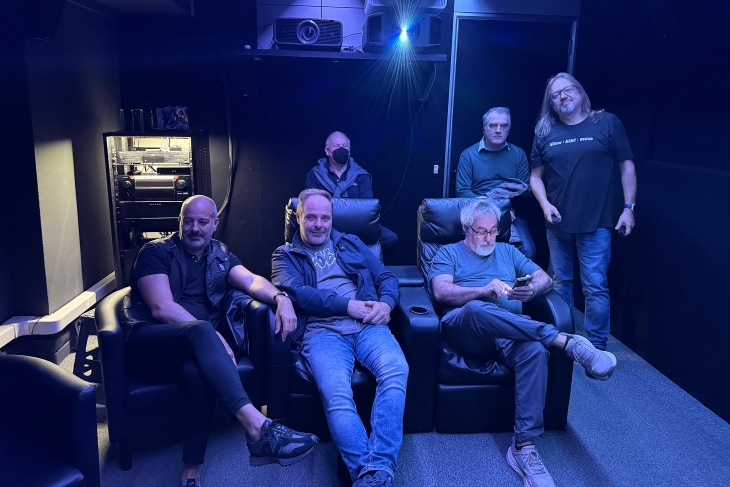rooob
Active member
Ho trovato recentemente una discussione interessante su reddit con un commento che mi sembra estremamente chiaro nel descrivere gli effetti di una luminosità elevata (500, 600 nits o oltre) su materiale sdr:
https://www.reddit.com/r/Monitors/comments/uw35wq/how_much_does_brightness_matter_for_sdr_use/?rdt=61648
There are only so many stops of brightness that can be represented by 8 bits color, as the brightness gets higher the larger the gap between each stop and therefore more visible banding.
8-bits = 256 values for R, G and B. Let's say 255 is the color maxed out (max brightness) and 0 is the color completely turned off (min brightness). Let's say you have a 255nits display that scales perfectly with the RGB values (in reality, that's not how things work, but I'm simplifying to explain the concept), that means every step increases 1 nit. 8-bit = 256 steps (0-255), 255 nits display, 1 nit per step. Easy, right?
Now, let's say you increase the brightness to 511 nits, but keep 8-bit color output (SDR), now every step increases 2 nits, so there's a bigger light output difference between each step = noticeable visual banding. The closer each step is to the previous step in brightness output, the less we can perceive banding. The bigger each step is in brightness, the more banding becomes noticeable.
This is why HDR uses 10-bit color (or more). Because if you want to go from 0 to 1000 nits (or more) with no visible banding, you need far more than 8-bit color precision. With 10-bit, you now have 1024 values of R, G and B; each channel has four times as much values (so four times as many steps) as 8-bit SDR. So, far more color values, to account for far more brightness steps without running into banding.
Now, in your specific question, which is essentially just increasing backlight brightness (that's only something for LCD-based displays; OLEDs have no backlight, as each pixel emits its own light), when you increase the backlight brightness of your display, you're not actually increasing its dynamic range (which puts it in stark contrast to OLED displays; increasing OLED light output will always increase dynamic range). If you're not increasing the dynamic range, technically you're not increasing the banding (though any previous banding you couldn't see because the backlight was dialed down might now be perceptible with higher backlight). You're just shifting the entire color response to a brighter level; which INCLUDES the dark areas (essentially; brighter backlight = brighter darks, so you're essentially compromising your dark levels). This is why there's only so far you can take LCD SDR brightness before things begin to look like a complete shitshow (look at the right picture to get a good understanding).
TL;DR: SDR LCD too bright = ruined dark/black levels (blacks become "gray"). OLED SDR too bright = banding.
https://www.reddit.com/r/Monitors/comments/uw35wq/how_much_does_brightness_matter_for_sdr_use/?rdt=61648
There are only so many stops of brightness that can be represented by 8 bits color, as the brightness gets higher the larger the gap between each stop and therefore more visible banding.
8-bits = 256 values for R, G and B. Let's say 255 is the color maxed out (max brightness) and 0 is the color completely turned off (min brightness). Let's say you have a 255nits display that scales perfectly with the RGB values (in reality, that's not how things work, but I'm simplifying to explain the concept), that means every step increases 1 nit. 8-bit = 256 steps (0-255), 255 nits display, 1 nit per step. Easy, right?
Now, let's say you increase the brightness to 511 nits, but keep 8-bit color output (SDR), now every step increases 2 nits, so there's a bigger light output difference between each step = noticeable visual banding. The closer each step is to the previous step in brightness output, the less we can perceive banding. The bigger each step is in brightness, the more banding becomes noticeable.
This is why HDR uses 10-bit color (or more). Because if you want to go from 0 to 1000 nits (or more) with no visible banding, you need far more than 8-bit color precision. With 10-bit, you now have 1024 values of R, G and B; each channel has four times as much values (so four times as many steps) as 8-bit SDR. So, far more color values, to account for far more brightness steps without running into banding.
Now, in your specific question, which is essentially just increasing backlight brightness (that's only something for LCD-based displays; OLEDs have no backlight, as each pixel emits its own light), when you increase the backlight brightness of your display, you're not actually increasing its dynamic range (which puts it in stark contrast to OLED displays; increasing OLED light output will always increase dynamic range). If you're not increasing the dynamic range, technically you're not increasing the banding (though any previous banding you couldn't see because the backlight was dialed down might now be perceptible with higher backlight). You're just shifting the entire color response to a brighter level; which INCLUDES the dark areas (essentially; brighter backlight = brighter darks, so you're essentially compromising your dark levels). This is why there's only so far you can take LCD SDR brightness before things begin to look like a complete shitshow (look at the right picture to get a good understanding).
TL;DR: SDR LCD too bright = ruined dark/black levels (blacks become "gray"). OLED SDR too bright = banding.




